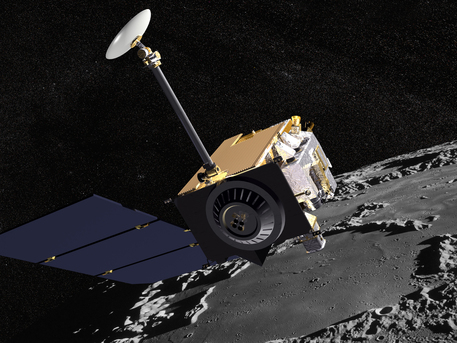Basic facts about LRO
NASA's journey back to the Moon starts Thursday
NASA's Lunar Reconnaissance Orbiter (LRO) and Lunar Crater Observation and Sensing Spacecraft will fly to the moon atop the same Atlas V rocket, although they will use vastly different methods to study the lunar environment. LRO will go into orbit around the moon, turning its suite of instruments towards the moon for thorough studies. The spacecraft also will be looking for potential landing sites for astronauts.
 © NASA |
Artist Concept of the Lunar Reconnaissance Orbiter with Apollo mission imagery in the background.
If you have never heard of the Lunar Reconnaissance Orbiter (LRO), here are some quick things you should know:
Redshift live will keep you updated about the mission and give more background information as this fascinating endeavor progresses.
NASA
- LRO is leading NASA’s way back to the moon.
- The primary objective of LRO is to conduct investigations preparing for future exploration of the moon. Specifically LRO will scout for safe and compelling lunar landing sites, locate potential resources with special attention to the possibility of water ice, and characterize the effects of prolonged exposure to the lunar radiation environment. In addition to its exploration mission, LRO will also return rich scientific data that will help us to better understand the moon’s topography and composition.
- The instrument payload of LRO consists of seven scientific instruments from partner institutions around the nation and globe, including one instrument contributed by the Institute for Space Research in Moscow. These instruments will return lunar imagery, topography, temperatures, and more.
- Launching along with LRO is the Lunar CRater Observation and Sensing Satellite (LCROSS), a partner mission that will search for water ice on the moon by sending a SUV-sized rocket stage into the permanent shadows of a polar crater. LCROSS will fly into the plume of dust left by the impact and take measurements of its properties before also colliding with the lunar surface.
- In response to LRO’s “Send Your Name to the Moon” web site, the spacecraft carries a microchip with nearly 1.6 million names that were submitted by the public.
Redshift live will keep you updated about the mission and give more background information as this fascinating endeavor progresses.
NASA
Basic facts about LRO
NASA's journey back to the Moon starts Thursday
NASA's Lunar Reconnaissance Orbiter (LRO) and Lunar Crater Observation and Sensing Spacecraft will fly to the moon atop the same Atlas V rocket, although they will use vastly different methods to study the lunar environment. LRO will go into orbit around the moon, turning its suite of instruments towards the moon for thorough studies. The spacecraft also will be looking for potential landing sites for astronauts.
 © NASA |
Artist Concept of the Lunar Reconnaissance Orbiter with Apollo mission imagery in the background.
If you have never heard of the Lunar Reconnaissance Orbiter (LRO), here are some quick things you should know:
Redshift live will keep you updated about the mission and give more background information as this fascinating endeavor progresses.
NASA
- LRO is leading NASA’s way back to the moon.
- The primary objective of LRO is to conduct investigations preparing for future exploration of the moon. Specifically LRO will scout for safe and compelling lunar landing sites, locate potential resources with special attention to the possibility of water ice, and characterize the effects of prolonged exposure to the lunar radiation environment. In addition to its exploration mission, LRO will also return rich scientific data that will help us to better understand the moon’s topography and composition.
- The instrument payload of LRO consists of seven scientific instruments from partner institutions around the nation and globe, including one instrument contributed by the Institute for Space Research in Moscow. These instruments will return lunar imagery, topography, temperatures, and more.
- Launching along with LRO is the Lunar CRater Observation and Sensing Satellite (LCROSS), a partner mission that will search for water ice on the moon by sending a SUV-sized rocket stage into the permanent shadows of a polar crater. LCROSS will fly into the plume of dust left by the impact and take measurements of its properties before also colliding with the lunar surface.
- In response to LRO’s “Send Your Name to the Moon” web site, the spacecraft carries a microchip with nearly 1.6 million names that were submitted by the public.
Redshift live will keep you updated about the mission and give more background information as this fascinating endeavor progresses.
NASA





